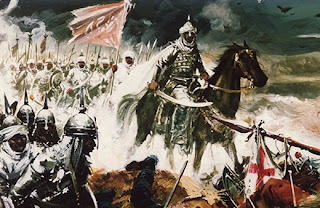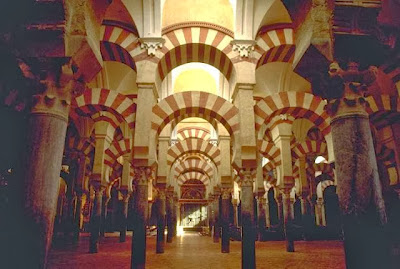The Iberian Peninsula
 The Iberian Peninsula is a geographic unit that contains a number of distinct regions based on climate and geomorphology, such as Andalusia, Castile, Galicia, and Lusitania. Lusitania, which now encompasses the modern nation-state of Portugal, is generally set off from the other regions of the peninsula by areas of higher elevation that run parallel to the Atlantic coast, greater rainfall, and a more moderate climate.
The Iberian Peninsula is a geographic unit that contains a number of distinct regions based on climate and geomorphology, such as Andalusia, Castile, Galicia, and Lusitania. Lusitania, which now encompasses the modern nation-state of Portugal, is generally set off from the other regions of the peninsula by areas of higher elevation that run parallel to the Atlantic coast, greater rainfall, and a more moderate climate.It was this regional distinctiveness, as well as the internal geography of Lusitania--largely open to the south but hemmed in by mountains on the east and the Atlantic Ocean on the west--that gave rise to a culturally and socially distinct people, the Portuguese, and later to an independent nation-state, Portugal.
Early Inhabitants
Lusitania has been inhabited since the Paleolithic period. Implements made by humans have been found at widely scattered sites. The Ice Ages did not touch Lusitania, and it was only after the disappearance of the Paleolithic hunting cultures that a warmer climate gave rise to a river-centered culture.
At the end of the Paleolithic period, about 7000 B.C., the valley of the Tagus River (Portuguese, Rio Tejo was populated by hunting and fishing tribes, who lived at the mouths of the river's tributaries.
These people left huge kitchen middens containing the remains of shellfish and crustaceans, as well as the bones of oxen, deer, sheep, horses, pigs, wild dogs, badgers, and cats. Later, perhaps about 3000 B.C., Neolithic peoples constructed crude dwellings and began to practice agriculture.
They used polished stone tools, made ceramics, and practiced a cult of the dead, building many funerary monuments called dolmens.
By the end of the Neolithic period, about 2000 B.C., regions of cultural differentiation began to appear among the Stone Age inhabitants of the Iberian Peninsula, one of these being the western Megalithic culture.
Present-day Portugal is thus rich in Megalithic neocropolises, the best known of which are at Palmela, Alcalar, Reguengos, and Monsaraz.
The Paleolithic and Neolithic periods were followed by the Bronze Age and the Iron Age (probably between 1500 and 1000 B.C.).
 |
| Citania Briteiros |
Engraving of Foz Côa

The oldest engraving of Foz Côa (until March 95) belonged to the" Solutrense médio antigo" with more or less 20 000 years. One of them is named the "Canada do Inferno". They are the more evident probe of the human living in the portuguese territory, at the ancient times.( The "Cultura Solutrense" is placed near the 18 000 BC to 15 000 BC)
Phoenicians and Celtic People
In the tw
 elfth century B.C., Phoenicians arrived on the west coast of the Iberian Peninsula in search of metals and founded trading posts at Cádiz, Málaga, and Seville. They traded with the peoples of the interior, taking out silver, copper, and tin and bringing in eastern trade goods.
elfth century B.C., Phoenicians arrived on the west coast of the Iberian Peninsula in search of metals and founded trading posts at Cádiz, Málaga, and Seville. They traded with the peoples of the interior, taking out silver, copper, and tin and bringing in eastern trade goods.Between the eighth century and sixth century B.C., successive waves of Celtic peoples from central Europe invaded the western part of the peninsula, where the topography and climate were well suited to their herding-farming way of life. They settled there in large numbers and blended in with the indigenous Iberos, giving rise to a new people known as Celtiberians.
Their settlements were hilltop forts called castros, of which there are many vestiges in northern Portugal.
Greeks
Later, d
 uring the seventh century B.C., Greeks arrived and founded several colonies, including Sargunto on the Mediterranean coast and Alcácer do Sal on the Atlantic coast. During the fifth century B.C., the Carthaginians replaced the Phoenicians and closed the Straits of Gibraltar to the Greeks.
uring the seventh century B.C., Greeks arrived and founded several colonies, including Sargunto on the Mediterranean coast and Alcácer do Sal on the Atlantic coast. During the fifth century B.C., the Carthaginians replaced the Phoenicians and closed the Straits of Gibraltar to the Greeks.The Carthaginians undertook the conquest of the peninsula but were only able to permanently occupy the territory in the south originally controlled by their Phoenician and Greek predecessors.
The Carthaginian occupation lasted until the defeat of Carthage by the Romans in the third century B.C.
Carthaginians
The Rom ans made the former Carthaginian territory into a new province of their expanding empire and conquered and occupied the entire peninsula. This invasion was resisted by the indigenous peoples, the stiffest resistance coming from the Lusitanians who lived in the western part of the peninsula.
ans made the former Carthaginian territory into a new province of their expanding empire and conquered and occupied the entire peninsula. This invasion was resisted by the indigenous peoples, the stiffest resistance coming from the Lusitanians who lived in the western part of the peninsula.
The Lusitanians were led by warrior chieftains, the most powerful of whom was Viriato.
Viriato held up the Roman invasion for several decades until he was murdered in his bed by three of his own people who had been bribed by the Romans.
His death brought the Lusitanian resistance to an end, and Rome relatively quickly
conquered and occupied the entire peninsula. The Portuguese have claimed Viriato as the country's first great national hero.
The Rom
 ans made the former Carthaginian territory into a new province of their expanding empire and conquered and occupied the entire peninsula. This invasion was resisted by the indigenous peoples, the stiffest resistance coming from the Lusitanians who lived in the western part of the peninsula.
ans made the former Carthaginian territory into a new province of their expanding empire and conquered and occupied the entire peninsula. This invasion was resisted by the indigenous peoples, the stiffest resistance coming from the Lusitanians who lived in the western part of the peninsula.The Lusitanians were led by warrior chieftains, the most powerful of whom was Viriato.
Viriato held up the Roman invasion for several decades until he was murdered in his bed by three of his own people who had been bribed by the Romans.
 |
| Death of Viriato |
conquered and occupied the entire peninsula. The Portuguese have claimed Viriato as the country's first great national hero.



















